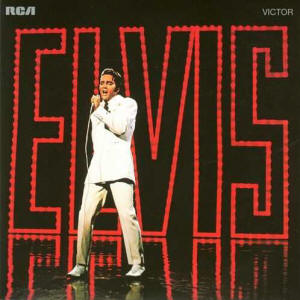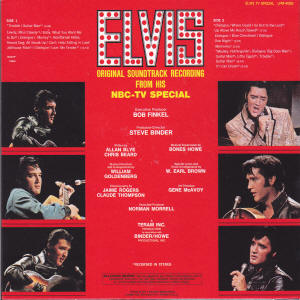Verdict
With this retrospective Elvis reported back as the king of rock'n'roll and also proved, that he was able to handle modern, even political songs well.
![]()
(C) RCA Records
The ultimate site about the king of the analogue age


On November 22, 1968 RCA Victor released the soundtrack of the television special "SINGER presents Elvis". With sales of 500,000 units "Elvis" entered the "Top LPs Chart" on December 21st, had a run of 32 weeks and peaked at number 8. In 1969 the RIAA honored the domestic sales with a Gold Award, in 1999 the status was updated to Platinum. Outside the US the demand was huge, too. In total "Elvis" sold 3 million copies, which equals 450 million paid streams of the complete album or 4.5 billion streams of individual tracks. Commercially the soundtrack was the most successful longplayer since "How Great Thou Art", to find sales like this on a regular basis one even had to go back to 1965.
In 2016 the complete Presley catalogue was restored and remastered by Vic Anesini for a boxed set of 60 compact discs called "The Album Collection". Sony Music Entertainment provides the streaming platforms with the same versions of the individual albums (some of them offering bonus tracks), albeit in 24 bit/90 khz flac. That means, if the platform of your choice supports high resolution audio, you can enjoy the tracks in the same quality Sony used to scan and master them. On Spotify, which has a market share of approximately 30% and is the only platform that publishes streaming figures, "Elvis" accumulates 151 million streams with over 50,000 requests per day. But it has to be mentioned, that Sony's "68 Comeback Special - 50th Anniversary Edition" adds another 234 million streams and "The Best Of The '68 Comeback Special" clocks in at an astonishing 1.2 billion streams. So with more than 1.5 billion requests combined I dare to say, that the 1968 NBC recordings are quite popular.
The cover shot was taken during the finale of the show and can be called iconic. The backside was made up with five photos from the show and a picture from the rehearsal session. Unfortunately nobody at RCA realized, that there already had been an album named "Elvis" in 1956. However, in 1973 the label would issue a third longplayer of this name.
Between June 20th and 24th the group worked at Western Recorders in Burbank/California. The sessions were produced by Steve Binder and engineered by Dayton Howe. Elvis' band consisted of Tommy Tedesco (guitar), Michael Deasy (guitar), Al Casey (guitar), Larry Knechtal (bass & keyboard), Charles Berghofer (bass), Don Randi (piano), Hal Blaine (drums), John Cyr (percussion), Elliot Franks (percussion), Frank DeVito (bongos), Tommy Morgan (harmonica), Bob Alberti (keyboard) and Tommy Wolfe (keyboard). The harmony vocals were provided by The Blossoms (Darlene Love, Jean King and Fanita James) as well as Julie Rinker, B.J. Baker, Frank Howren, Bill Lee, Gene Merlino, Thurl Ravenscroft, Bill Brown, Joe Eich, Elaine Back, Dean Parker, Jack Gruberman, Sally Stevens, Jackie Ward, Ronald Hicklin, Tom Bahler and Mitch Gordon. The orchestra was conducted by William Goldenberg.
The live elements were split in two categories. On June 27, 1968 there were two "informal" shows at the NBC Studio in Burbank/California. The king was surrounded by Scotty Moore (guitar), DJ Fontana (percussion), Charlie Hodge (guitar), Alan Fortas (guitar) as well as Lance Legault (tambourine) and it was supposed to look like a spontaneous jam session. The other two shows were taped on June 29th. Here Elvis was alone on the stage, the musicians and singers were placed on the audience area. Here the king was accompanied by Tommy Tedesco (guitar), Michael Deasy (guitar), Al Casey (guitar), Larry Knechtal (bass & keyboard), Charles Berghofer (bass), Don Randi (piano), Hal Blaine (drums), John Cyr (perkussion), Elliot Franks (percussion), Frank DeVito (bongos) and Tommy Morgan (harmonica). The orchestra was conducted by William Goldenberg, the harmony vocals were provided by The Blossoms (Darlene Love, Jean King and Fanita James).
The editing was done on June 30th at NBC Studios in Burbank/California by Steve Binder (producer) and Dayton Howe (engineer). With a running time of 44:27 minutes "Elvis" was the king's longes running album to date.
In 2016 Follow That Dream Records released a collector's edition of "Elvis", which included bonus tracks and outtakes. For a review tap HERE.
Trouble / Guitar Man
It's obvious right from the start, that this is not the singing movie star of recent years. Elvis' voice sounds rough and unpolished. The combination of the classic "Trouble" with last year's "Guitar Man" connects the king's past to the present and demonstrates, that this is still the same singer, still the king of rock'n'roll. The medley was recorded on June 22, 1968 and is a splice of the takes 21 (Trouble) and 32/19 (Guitar Man).
Lawdy, Miss ClawdyThis one was recorded during the second "informal" show on June 27, 1968. Elvis sounds more rough than twelfe years before and also puts more energy into the old track. The instrumentation is very sparse, which adds to the atmosphere.
Baby What You Want Me To DoHere we get the first new track of the album. The song was written by Jimmy Reed, who had released it back in 1959. Elvis hadn't recorded "Baby What You Want Me To Do" before. His performance was also taped on June 27th, but this time during the first "informal" session. It's almost unbelievable, that this is the same singer, who had recently issued rubbish like "Old Mac Donald" or "Confidence".
Heartbreak Hotel / Hound Dog / All Shook UpNow the album switches to the "arena shows", during which Elvis was accompanied by an electric band, an orchestra and harmony singers. The hit medley was recorded during the first concert on June 29, 1968. Once again the king sounds more rough than ever before, the orchestra adds some (at the time) modern elements.
Can't Help Falling In LoveThis track was taped during the same show. Elvis sings the ballad well and I like the orchestra arrangement, too. But nevertheless this re-recording doesn't match the beauty of the original version. It's simply unbeatable.
Jailhouse RockElvis and the band are running at full throttle. The reactions of the ladies prove, that the aged rock'n'roll king still is the master of the art.
Love Me TenderDue to the orchestra, the performance differs vastly from the original recording. It's still not one of my favorites, but at least it doesn't sound as boring as the original recording.
Gospel MedleyOf course gospel music also had to be included in this retrospective and so the b-side of the longplayer opens with a medley of "Where Could I Go But To The Lord", "Up Above My Head" and "Saved". The fans knew the first song from the previous year's album "How Great Thou Art", the others had been released by The Southern Sons in 1941 and LaVern Baker in 1960. Elvis is completely caught up in the songs, just like he did with "Love Me" he ignores the irony of "Saved" and performs the Leiber/Stoller track completely seriously. The medley was recorded song by song and edited together later. "Where Could I Go But To The Lord" was taped on June 21, 1968 within seven takes. On the same day Elvis also recorded "Up Above My Head", but wasn't satisfied with any take. On the next day he taped two more takes of the song as well as six attempts of "Saved". The final master was a splice of take 7 of "Where Could I Go But To The Lord", take 13 of "Up Above My Head" and a combination of the takes 5 and 6 of "Saved".
Blue ChristmasThe rendition of Elvis' most popular Xmas song was recorded during the second "informal" session on June 27th. The king's statement, that this was his favorite of the Christmas songs recorded by him was borrowed from the presentation of "Santa Claus Is Back In Town". The performance of "Blue Christmas" was shortened.
One NightHere we have a great, rough and powerful rendition of "One Night". The sparse instrumentation just adds to the effect, I also like, that Elvis includes a few lines of "One Night Of Sin". The performance was recorded during the first "informal" show on June 27, 1968.
MemoriesThis is another new song. Billy Strange and Mac Davis wrote "Memories", in which the narrator remembers his lost love. The rhythm track was recorded on June 23, 1968 within four takes, Elvis added his vocals the following day. Obviously the ballad was no challenge to him, because he needed just two attempts to get it right. In March 1969 RCA Victor released the song on a single, but it never made it past number 35 of the "Hot 100". Nevertheless Elvis included it in almost every show of his comeback engagement at the International Hotel in Las Vegas.
Road MedleyThis medley demostrates the singer's rise to fame. It starts with "Nothingville", a song by Billy Strange and Mac Davis. It's about a small town somewhere in America, which the singer has to leave if he wants to make it big. In "Big Boss Man" he fights with his boss, "Guitar Man" is the start of his odyssey as a musician. He finds work in a small club and sings "Little Egypt". The next step of his career is symbolized by a performance of "Trouble" in a more luxurious location, finally Elvis ends up in the arena of his tv show and performs a special verse of "Guitar Man". He made it to the top, but his journey isn't over yet. The medley is well done, the king's re-recording of "Little Egypt" is much better than his original performance. Just like "The Gospel Medley", this one was also recorded in segments. "Nothingville" and "Big Boss Man" were taped on June 20th. For the first one Elvis needed 10 takes, the second one was finished in 3 attempts. On the next day he recorded "Guitar Man" (seven takes), "Little Egypt" (ten takes) and the combination of "Trouble" and "Guitar Man" (three takes).
If I Can DreamThe finale was already known from the single "If I Can Dream" / "Edge Of Reality", which had been released in November and peaked at number 12 of the "Hot 100". It turned out to be the king's most successful 45 since "Crying In The Chapel" in 1965. The song was written by W. Earl Brown and recorded by Elvis on June 23, 1968 within five takes. RCA later re-released "If I Can Dream" on the boxed set "Worldwide 50 Gold Award Hits - Volume 1" (1970) and "A Legendary Performer - Volume 2" (1976).
With this retrospective Elvis reported back as the king of rock'n'roll and also proved, that he was able to handle modern, even political songs well.
![]()
(C) RCA Records